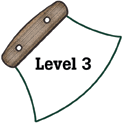
Alaska Science
Key Element D4
A student who meets the content standard should evaluate the scientific and social merits of solutions to everyday problems.
 |
Alaska Science A student who meets the content standard should evaluate the scientific and social merits of solutions to everyday problems. |
|
Performance Standard Level 3, Ages 11–14
|
|
|
|
Sample Assessment Ideas
|
|
|
Expanded Sample Assessment Idea Mini-Unit: HIV
|
|
Procedure Students will:
|
Levels of Performance |
||
|
Stage 4 |
Student report includes a thorough investigation of the effects of the HIV virus, its transmission, and the methods to limit its spread. The report is detailed, extensive, and includes evidence of clear and logical reasoning | ||
|
Stage 3
|
Student report includes a thorough investigation of the effects of the HIV virus, its transmission, and the methods to limit its spread, although equal importance may not be placed on all three aspects. The report is detailed and includes evidence of clear and logical reasoning. Minor errors do not affect the results. | ||
|
Stage 2
|
Student report shows limited evidence of investigation of the HIV virus, its transmission, and methods to limit its spread. Student work is incomplete and may contain errors of scientific fact or reasoning. | ||
|
Stage 1
|
Student report shows little or no evidence of investigation of the HIV virus, its transmission, and methods to limit its spread. The report is largely incomplete, incorrect, or contains evidence of misconceptions related to scientific reasoning. | ||
Table of Contents | Return to Alaska Native Knowledge Network